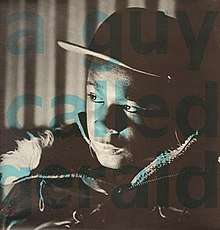Voodoo Ray
"Voodoo Ray" is a 1988 acid house single by Gerald Simpson, recording under the name A Guy Called Gerald. The single was released in the UK in 1988, in the 7" and 12" vinyl formats, on the Rham! label. It was released in the United States in 1989 by Warlock Records.
| "Voodoo Ray" | ||||
|---|---|---|---|---|
 | ||||
| Single by A Guy Called Gerald | ||||
| Released | 1988 | |||
| Recorded | June 1988 | |||
| Genre | Acid house | |||
| Length | 4:27 | |||
| Label | ||||
| Songwriter(s) | ||||
| Producer(s) | Gerald Simpson, Chapter | |||
| A Guy Called Gerald singles chronology | ||||
| ||||
The single spent 18 weeks on the UK Singles Chart eventually reaching number 12, and was awarded best selling independently released single of 1989 by Music Week and the British Phonographic Industry. The track became a popular acid house anthem associated with Manchester club The Haçienda.[1]
Recording
"Voodoo Ray" and the surrounding EP were recorded over two days in June 1988 at Moonraker Studios in Manchester.[2] The session featured production assistance from the duo of Aniff Akinola and Colin Thorpe (together credited as Chapter), as well as engineer Lee Montedverde.[1] The recording was based on an earlier home demo recorded by Simpson.[1] Simpson explained:
I was trying to keep it quiet from the dudes in 808 State, because I was still working with them but wanted to do my own thing. It was fun just slipping out of their basement and taking the drum machine. They'd be like, 'Where are you going?' I'd say, 'Oh, I'm just going home to do some programming,' then nip off to another studio.[3]
The track contains samples of comedians Peter Cook and Dudley Moore, taken from the first Derek and Clive LP, Derek and Clive (Live), specifically the "Bo Duddley" sketch.[4][5] "Voodoo Ray" combines a sample of Cook delivering the phrase "voodoo rage", truncated due to the recording equipment's lack of memory, and also Moore forcefully delivering the word "later!". Gerald explained: "I was trying to get a tribal sound and found this sample saying 'Voodoo rage'. That was originally the title but the old sampler I was using didn't have that much memory. I just about had enough for 'voodoo ra…', so that's what it became."[6]
The vocal was sung by Nicola Collier, who had worked on other tracks with Simpson,[7][8] with the vocal melody suggested by Thorpe and later chopped up by Simpson using an Akai S-950 sampler.[1]
Release
Rham! initially pressed up 500 copies of the record and it sold out in a day.[9] It received support from local DJs and eventually became an anthem at Manchester club The Haçienda.[1]
A version of the track also appeared on A Guy Called Gerald's 1988 album Hot Lemonade, and a re-recorded version called "Voodoo Ray Americas" appeared on A Guy Called Gerald's 1990 album Automanikk, which was released by Columbia and CBS Records.
In 2019, journalist Matt Anniss wrote that "Voodoo Ray" "may now be one of the most recognizable House records ever made, but the track has lost none of its charm or power."[1] Anniss also opined that the four-track EP "has held up remarkably well," calling the additional tracks "similarly weighty, inspired and off kilter."[1]
In popular culture
In 1995, Simpson re-modelled the original samples to create a new track, "Voodoo Rage", for his Black Secret Technology album.
The song is featured on the soundtrack of the 2002 film 24 Hour Party People (directed by Michael Winterbottom) that tells the story of Factory Records and the early Madchester scene.[10] The song is also featured in the radio station SF-UR in the 2004 game Grand Theft Auto: San Andreas. The song appears in filmmaker Cheryl Dunye's She Don't Fade (1991).
A Steelpan cover version was also used in artist Jeremy Deller's work English Magic, which was displayed at the Venice Bienale in 2013.
Track list
7" version
- "Voodoo Ray (Radio Mix)" - 4:18
- "Arcade Fantasy" - 4:43 (engineered by Adam Lesser)
12" and CD version
- "Voodoo Ray" - 4:28
- "Escape" - 5:16
- "Rhapsody in Acid" - 5:23
- "Blow Your House Down" - 5:03
Personnel
- A Guy Called Gerald - writer, producer
- Chapter (Aniff Akinola and Colin Thorpe) - co-producer
- Lee Monteverde - engineer
- JA - mastering
References
- Anniss, Matt (2019). Join the Future: Bleep Techno and the Birth of British Bass Music. Velocity. pp. 72–74. ISBN 9781913231002.
- Stuart Aitken (May 2005). "Voodoo Ray: I Raved with a Zombie". Mojo Magazine.
- Q, May 2001
- "A Guy Called Gerald - Voodoo Ray (Vinyl) at Discogs". Discogs.com. Retrieved 7 July 2011.
- Richards, Sam (3 September 2015). "From Voodoo Ray to Infinity and beyond – the story of the UK's biggest rave anthems". theguardian.com. Retrieved 4 September 2015.
- Q, May 2001
- "DJ History interview A Guy Called Gerald | Class of 808: Acid House to Hardcore". Class of 808. Retrieved 7 July 2011.
- 1989: Bob Dylan didn't have this to ... - Google Books. Retrieved 7 July 2011.
- Stuart Aitken (May 2005). "Voodoo Ray: I Raved with a Zombie". Mojo Magazine.
- "City Life - Issue 498 - 13th August 2003 - "A Guy Thing" - Article". Homepages.force9.net. 13 August 2003. Retrieved 7 July 2011.